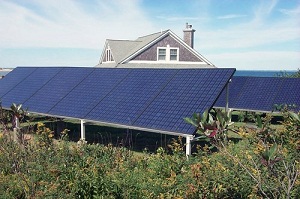Hagerstown to allow ground-mounted PV
 Towns and cities across the nation are in various stages of bringing solar and other renewable power into residents’ homes and into their backyards, as residents and businesses attempt to cash in on heavy state and federal incentives. However, in some cases, as in the case of Hagerstown, Md., regulations allowing renewables like photovoltaics (PV) in residents’ and businesses properties is being written now.
Towns and cities across the nation are in various stages of bringing solar and other renewable power into residents’ homes and into their backyards, as residents and businesses attempt to cash in on heavy state and federal incentives. However, in some cases, as in the case of Hagerstown, Md., regulations allowing renewables like photovoltaics (PV) in residents’ and businesses properties is being written now.
Hagerstown is a small city that’s about a two-hour drive from the nation’s capitol and is currently home to the state’s largest PV array, located at a Staples distribution center.
Hagerstown’s city council met in early November to discuss how best to allow its residents and businesses to incorporate solar into their properties.
“The issue with solar and wind energy systems is that because we didn’t have any regulations; technically it’s not permitted,” said city councilperson Ashley Haywood. “We weren’t saying you can’t do it; we didn’t say anything at all.”
Roof-mounted solar systems already are allowed. But ground-mounted installations pose a different regulatory hurdle.
While the city’s council and mayor are in favor of ordinances that would allow such systems in residents’ backyards and on business properties, the city planning commission’s position was to allow businesses to install such production, but not residents.
“This is all in a process to have language in our zoning ordinance related to solar and wind,” said Clayton Zug, Hagerstown’s city planning inspector. He had recommended that solar and wind installations be allowed at residences with restrictions similar to those placed on other structures built on residential properties.
Despite Zug’s suggestion, the planning commission recommended that such installations not be allowed in residences.
Zug said the commission came to its conclusion because, among other things, most residents put solar on their roofs. “And 90 percent of lots [in the town] are under a half acre,” he said.
While most residences do place solar on their roofs, ground-mounted systems are sometimes more appropriate.
For instance, when a home’s roof doesn’t face the sun or is obstructed by trees, or when it’s a historical property that can’t be altered. And ground-mounts can offer some advantages, like being placed on a solar tracker to increase output efficiency.
According to Haywood, the city has seen a lot of interest in renewables lately as commercial companies rush to beat deadlines for incentives before they expire.
“We’ve gotten a great response from residents [on solar]—mostly positive reinforcement,” Haywood said. “We haven’t seen too much interest in the form of residential incentives.”
But she said that should happen eventually. And the city wants to make sure it’s prepared for just that.
Image courtesy of NREL.



